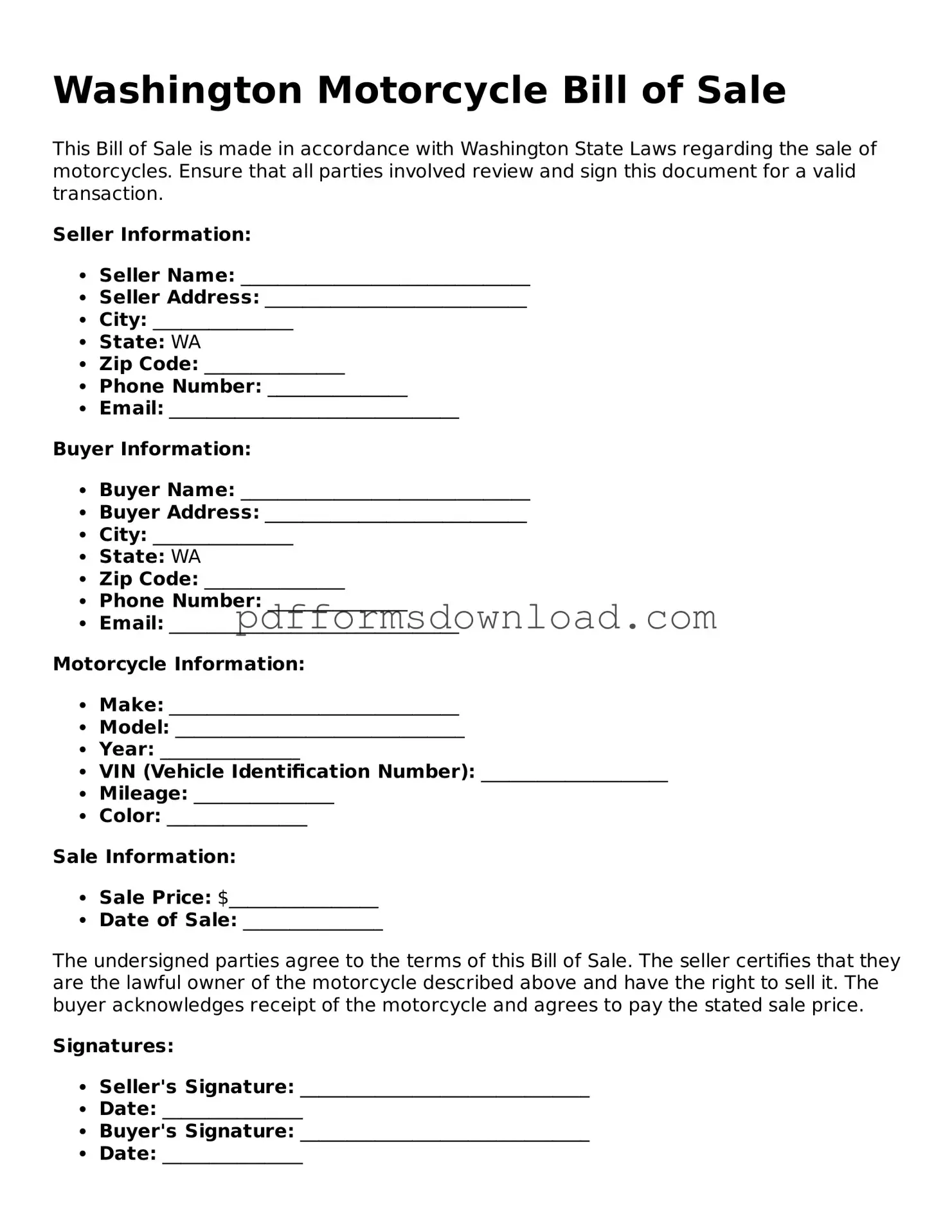What is a Washington Motorcycle Bill of Sale form?
The Washington Motorcycle Bill of Sale form is a legal document that records the sale of a motorcycle from one person to another. It serves as proof of the transaction and includes important details about the motorcycle, the buyer, and the seller. This document can be essential for registering the motorcycle and transferring ownership in Washington State.
Why do I need a Bill of Sale for my motorcycle?
A Bill of Sale is important for several reasons. First, it provides a written record of the transaction, which can protect both the buyer and the seller. It helps establish ownership and can be useful if any disputes arise later. Additionally, the Washington Department of Licensing may require this document when you register the motorcycle in your name.
What information is included in the Bill of Sale?
The Bill of Sale typically includes the names and addresses of both the buyer and seller, the motorcycle's make, model, year, and Vehicle Identification Number (VIN). It should also state the sale price and the date of the transaction. Some forms may also include a section for odometer disclosure, which is important for transparency regarding the motorcycle's mileage.
Do I need to have the Bill of Sale notarized?
In Washington State, notarization is not required for the Motorcycle Bill of Sale. However, having the document notarized can add an extra layer of security and authenticity, which might be beneficial if there are any future disputes regarding the sale.
Can I use a generic Bill of Sale form for my motorcycle?
While you can use a generic Bill of Sale form, it’s best to use one specifically designed for motorcycles. This ensures that all necessary information is included and complies with Washington State requirements. A motorcycle-specific form will typically address unique aspects of motorcycle sales, such as odometer readings and specific identification details.
Is there a fee for the Bill of Sale?
There is no fee for creating a Bill of Sale itself, as it is a document that you can draft yourself or obtain from various online sources. However, there may be fees associated with registering the motorcycle with the Washington Department of Licensing after the sale is completed.
How do I complete the Bill of Sale?
To complete the Bill of Sale, fill in all required fields accurately. Include the names and addresses of both parties, the motorcycle's details, and the sale price. Both the buyer and seller should sign the document to confirm the transaction. Make sure to keep a copy for your records, as it will be needed for registration and any future reference.
What should I do if the seller does not provide a Bill of Sale?
If the seller does not provide a Bill of Sale, it is advisable to request one. Without this document, you may face challenges when trying to register the motorcycle in your name. If the seller refuses, consider documenting the transaction in writing, including details of the sale and both parties' signatures. This can serve as a makeshift Bill of Sale, though it may not carry the same weight as a formal document.
How long should I keep the Bill of Sale?
It is wise to keep the Bill of Sale for as long as you own the motorcycle. This document serves as proof of ownership and can be useful for future transactions, such as selling the motorcycle again or addressing any legal issues that may arise. Once you sell the motorcycle, you may want to keep it for a few years in case any questions about the sale come up.
What if I lose the Bill of Sale?
If you lose the Bill of Sale, it can be problematic, especially if you need it for registration or proof of ownership. You may need to contact the seller to obtain a copy or create a new Bill of Sale if both parties agree. Documenting the loss and having the seller sign a new form can help clarify the situation.
